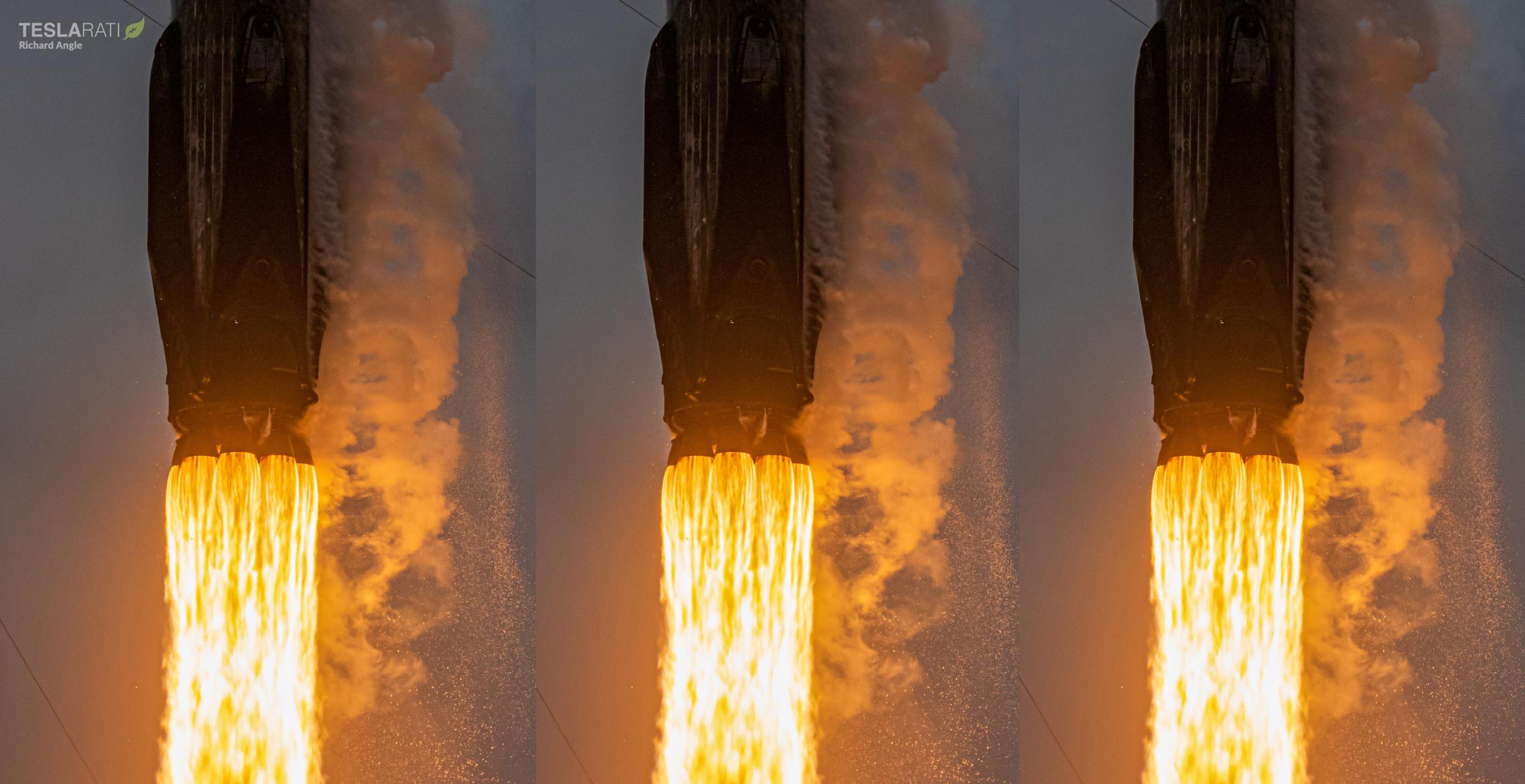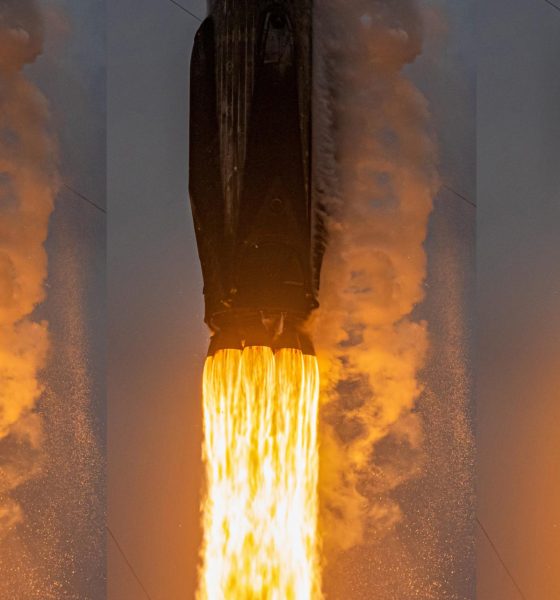

News
SpaceX to kick off launch triple-header with record-breaking Falcon reuse
SpaceX appears to be on track to launch a trio of Falcon 9 rockets in as few as 36 hours, beginning with a Starlink mission on June 17th.
Enabled in part by delays to an unrelated Cargo Dragon launch that recently slipped from June 7th to July 11th, a Falcon 9 rocket is scheduled to launch Starlink 4-19 out of SpaceX’s leased NASA Kennedy Space Center LC-39A pad no earlier than (NET) 12:08 pm EDT (16:08 UTC) on Friday, June 17th. Beyond kicking off a very busy weekend for SpaceX, the otherwise ordinary mission will be significant for a number of reasons previously discussed on Teslarati.
“Starlink 4-19 will be the 100th reuse of a Falcon booster since the first in March 2017. If all goes well, it will also mark SpaceX’s 50th consecutively successful Falcon booster landing and Falcon 9’s 130th consecutively successful launch campaign – just four successes away from breaking the world record of 133 consecutive successes set by variants of Russia’s Soyuz/R-7 rocket.”
In addition to those milestones, SpaceX recently confirmed that it assigned Falcon 9 booster B1060 to the launch. Since its debut in June 2020, B1060 has supported three commercial launches (GPS III SV03, Turksat 5A, Transporter-2) and nine Starlink launches, helping to deliver around 160 metric tons (~350,000 lb) of satellites to orbit in two years. Starlink 4-19 will be its 13th launch – the first time any Falcon booster has attempted to surpass a dozen flights. Starlink 4-19’s payload will be another 53 Starlink V1.5 satellites weighing around 16 tons (~35,250 lb), likely raising the total number of working Starlink satellites in orbit above 2400.
Following Starlink 4-19, SpaceX confirmed on Thursday that another Falcon 9 rocket is scheduled to launch a set of rideshare payloads and Germany’s SARah-1 radar satellite from Vandenberg Space Force Base (VSFB), California at 7:19 am PDT (14:19 UTC) on Saturday, June 18th. SpaceX won the contract to launch all three planned SARah satellites in 2013, at which point the first launch was expected to occur in 2018. The payloads are light enough that the mission’s unknown Falcon 9 booster will be able to boost back to shore and land just a thousand feet from where it lifted off after carrying them most of the way to space.
Just half a day after SARah-1, a third Falcon 9 rocket could lift off from LC-40 – SpaceX’s second East Coast pad – with a single spare Globalstar-2 communications satellite and one or more secret military satellites at 12:27 am EDT (04:27 UTC) on Sunday, June 19th. Falcon 9 booster B1061 is likely assigned to the launch and was spotted on a transporter – new, expendable upper stage already installed – on June 14th, probably heading from SpaceX’s main integration hangar to Cape Canaveral Space Force Station’s (CCSFS) LC-40 pad.
Given the difficult nature of orbital spaceflight, all three missions could run into minor delays, but if all fly as they are currently scheduled, SpaceX will have completed three orbital launches in 36 hours and 19 minutes. Starlink 4-19 and SARah-1 could also lift off just 10 hours apart.
SpaceX has two more missions tentatively scheduled in June. SES-22 could launch from the same pad as Globalstar-2 M087 (LC-40) as early as June 28th. While significantly less likely, NextSpaceflight.com suggests that SpaceX may also try to squeeze another Starlink launch – 4-21 – out of Pad 39A in late June. The margins for that opportunity are slim, however, as SpaceX will likely need to begin converting Pad 39A for Cargo Dragon’s July 11th launch by July 1st at the latest.
Tune in below around 11:55 am EDT to watch SpaceX’s record-breaking Starlink 4-19 launch live.

News
Tesla dispels reports of ‘sales suspension’ in California
“This was a “consumer protection” order about the use of the term “Autopilot” in a case where not one single customer came forward to say there’s a problem.
Sales in California will continue uninterrupted.”

Tesla has dispelled reports that it is facing a thirty-day sales suspension in California after the state’s Department of Motor Vehicles (DMV) issued a penalty to the company after a judge ruled it “misled consumers about its driver-assistance technology.”
On Tuesday, Bloomberg reported that the California DMV was planning to adopt the penalty but decided to put it on ice for ninety days, giving Tesla an opportunity to “come into compliance.”
Tesla enters interesting situation with Full Self-Driving in California
Tesla responded to the report on Tuesday evening, after it came out, stating that this was a “consumer protection” order that was brought up over its use of the term “Autopilot.”
The company said “not one single customer came forward to say there’s a problem,” yet a judge and the DMV determined it was, so they want to apply the penalty if Tesla doesn’t oblige.
However, Tesla said that its sales operations in California “will continue uninterrupted.”
It confirmed this in an X post on Tuesday night:
This was a “consumer protection” order about the use of the term “Autopilot” in a case where not one single customer came forward to say there’s a problem.
Sales in California will continue uninterrupted.
— Tesla North America (@tesla_na) December 17, 2025
The report and the decision by the DMV and Judge involved sparked outrage from the Tesla community, who stated that it should do its best to get out of California.
One X post said California “didn’t deserve” what Tesla had done for it in terms of employment, engineering, and innovation.
Tesla has used Autopilot and Full Self-Driving for years, but it did add the term “(Supervised)” to the end of the FSD suite earlier this year, potentially aiming to protect itself from instances like this one.
This is the first primary dispute over the terminology of Full Self-Driving, but it has undergone some scrutiny at the federal level, as some government officials have claimed the suite has “deceptive” naming. Previous Transportation Secretary Pete Buttigieg was vocally critical of the use of the name “Full Self-Driving,” as well as “Autopilot.”
News
New EV tax credit rule could impact many EV buyers
We confirmed with a Tesla Sales Advisor that any current orders that have the $7,500 tax credit applied to them must be completed by December 31, meaning delivery must take place by that date. However, it is unclear at this point whether someone could still claim the credit when filing their tax returns for 2025 as long as the order reflects an order date before September 30.

Tesla owners could be impacted by a new EV tax credit rule, which seems to be a new hoop to jump through for those who benefited from the “extension,” which allowed orderers to take delivery after the loss of the $7,500 discount.
After the Trump Administration initiated the phase-out of the $7,500 EV tax credit, many were happy to see the rules had been changed slightly, as deliveries could occur after the September 30 cutoff as long as orders were placed before the end of that month.
However, there appears to be a new threshold that EV buyers will have to go through, and it will impact their ability to get the credit, at least at the Point of Sale, for now.
Delivery must be completed by the end of the year, and buyers must take possession of the car by December 31, 2025, or they will lose the tax credit. The U.S. government will be closing the tax credit portal, which allows people to claim the credit at the Point of Sale.
🚨UPDATE: $7,500 Tax Credit Portal “Closes By End of Year”.
This is bad news for pending Tesla buyers (MYP) looking to lock in the $7,500 Tax Credit.
“it looks like the portal closes by end of the year so there be no way for us to guarantee the funds however, we will try our… pic.twitter.com/LnWiaXL30k
— DennisCW | wen my L (@DennisCW_) December 15, 2025
We confirmed with a Tesla Sales Advisor that any current orders that have the $7,500 tax credit applied to them must be completed by December 31, meaning delivery must take place by that date.
However, it is unclear at this point whether someone could still claim the credit when filing their tax returns for 2025 as long as the order reflects an order date before September 30.
If not, the order can still go through, but the buyer will not be able to claim the tax credit, meaning they will pay full price for the vehicle.
This puts some buyers in a strange limbo, especially if they placed an order for the Model Y Performance. Some deliveries have already taken place, and some are scheduled before the end of the month, but many others are not expecting deliveries until January.
Elon Musk
Elon Musk takes latest barb at Bill Gates over Tesla short position
Bill Gates placed a massive short bet against Tesla of ~1% of our total shares, which might have cost him over $10B by now

Elon Musk took his latest barb at former Microsoft CEO Bill Gates over his short position against the company, which the two have had some tensions over for a number of years.
Gates admitted to Musk several years ago through a text message that he still held a short position against his sustainable car and energy company. Ironically, Gates had contacted Musk to explore philanthropic opportunities.
Elon Musk explains Bill Gates beef: He ‘placed a massive bet on Tesla dying’
Musk said he could not take the request seriously, especially as Gates was hoping to make money on the downfall of the one company taking EVs seriously.
The Tesla frontman has continued to take shots at Gates over the years from time to time, but the latest comment came as Musk’s net worth swelled to over $600 billion. He became the first person ever to reach that threshold earlier this week, when Tesla shares increased due to Robotaxi testing without any occupants.
Musk refreshed everyone’s memory with the recent post, stating that if Gates still has his short position against Tesla, he would have lost over $10 billion by now:
Bill Gates placed a massive short bet against Tesla of ~1% of our total shares, which might have cost him over $10B by now
— Elon Musk (@elonmusk) December 17, 2025
Just a month ago, in mid-November, Musk issued his final warning to Gates over the short position, speculating whether the former Microsoft frontman had still held the bet against Tesla.
“If Gates hasn’t fully closed out the crazy short position he has held against Tesla for ~8 years, he had better do so soon,” Musk said. This came in response to The Gates Foundation dumping 65 percent of its Microsoft position.
Tesla CEO Elon Musk sends final warning to Bill Gates over short position
Musk’s involvement in the U.S. government also drew criticism from Gates, as he said that the reductions proposed by DOGE against U.S.A.I.D. were “stunning” and could cause “millions of additional deaths of kids.”
“Gates is a huge liar,” Musk responded.
It is not known whether Gates still holds his Tesla short position.








